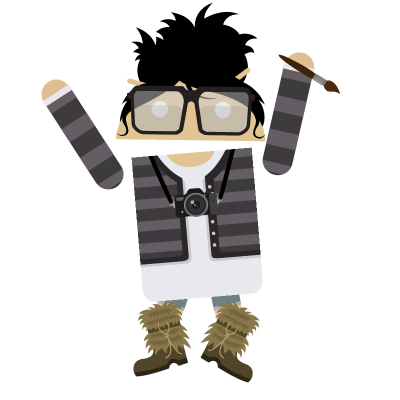CSS3 3D Transform
Used to allow 3D transformation to an element
- 3D is all about, playing with X-axis, Y-axis & Z-axis
- turned_in_notProperties
- transform
- transform-origin
- backface-visibility
- transform-style
- perspective
- perspective-origin
transform:Property 3D methods
- turned_in_not3D Transform Methods
perspective()
translate3d()translateX()translateY()translateZ()
rotate3d()rotateX()rotateY()rotateZ()
scale3d()scaleX()scaleY()scaleZ()
matrix3d()
- Alert: Below we are using limited values, you can use more values( +ve or -ve ) as per your need
perspective( )
It provides you a perspective view for a 3D transformed element
- It's required along with other methods to visualize 3D effect
- Note! If declaring, declare it before all other methods
- Perspective means, at what distance the element is placed from the view
perspective
value
perspective(300px) rotateX(50deg);
#perspective {
/*perspective(value-In_pixels)*/
transform:perspective(300px) rotateX(50deg);
}
<!DOCTYPE html>
<html>
<head>
<title>Full CSS Code</title>
<style>
#perspective {
/*perspective(value-In_pixels);*/
transform:perspective(300px) rotateX(50deg);
height:100px;
width:100px;
background-color:#3ba8df;
box-shadow: 4px 4px grey;
}
</style>
</head>
<body>
<div id="perspective" style="margin:auto;">
<h5 style="text-align:center;">perspective</h5>
</div>
</body>
</html>Translate3d
It changes the position of the element in 3D space
- For
translateX()&translateY(), See it in 2D transform - The values can be in pixels, %, or in other units
translateZ
Z
perspective(300px) translateZ(10px);
#translatez {
/*translateZ(Z-axis-value)*/
transform:perspective(300px) translateZ(10px);
}
<!DOCTYPE html>
<html>
<head>
<title>Full CSS Code</title>
<style>
#translatez {
/*translateZ(Z-axis-value)*/
transform:perspective(300px) translateZ(10px);
height:100px;
width:100px;
background-color:#3ba8df;
box-shadow: 4px 4px grey;
}
</style>
</head>
<body>
<div id="translatez" style="margin:auto;">
<h5 style="text-align:center;">translateZ</h5>
</div>
</body>
</html>translate3d
translateX
translateY
translateZ
perspective(300px) translate3d(10px,10px,10px);
#translate {
/*translate3d(translateX,translateY,translateZ);*/
transform:perspective(300px) translate3d(10px,10px,10px);
}
<!DOCTYPE html>
<html>
<head>
<title>Full CSS Code</title>
<style>
#translate {
/*translate3d(translateX,translateY,translateZ);*/
transform:perspective(300px) translate3d(10px,10px,10px);
height:100px;
width:100px;
background-color:#00ccc3;
box-shadow: 0 1px 2px #040404;
}
</style>
</head>
<body>
<div id="translate" style="margin:auto;">
<h5 style="text-align:center;">translate</h5>
</div>
</body>
</html>Rotate3d
It rotates the element in 3D space
rotateX
X
rotateX(10deg);
#rotatex {
/*transform:rotateX(In_degree);*/
transform:rotateX(10deg);
}
<!DOCTYPE html>
<html>
<head>
<title>Full CSS Code</title>
<style>
#rotatex {
/*transform:rotateX(In_degree);*/
transform:rotateX(10deg);
height:100px;
width:100px;
background-color:#ef5195;
box-shadow: 4px 4px grey;
}
</style>
</head>
<body>
<div id="rotatex" style="margin:auto;">
<h5 style="text-align:center;">rotateX</h5>
</div>
</body>
</html>rotateY
Y
rotateY(10deg);
#rotatey {
/*transform:rotateY(In_degree);*/
transform:rotateY(10deg);
}
<!DOCTYPE html>
<html>
<head>
<title>Full CSS Code</title>
<style>
#rotatey {
/*transform:rotateY(In_degree);*/
transform:rotateY(10deg);
height:100px;
width:100px;
background-color:#ffdd52;
box-shadow: 4px 4px grey;
}
</style>
</head>
<body>
<div id="rotatey" style="margin:auto;">
<h5 style="text-align:center;">rotateY</h5>
</div>
</body>
</html>rotateZ
Z
rotateZ(10deg);
#rotatez {
/*transform:rotateZ(In_degree);*/
transform:rotateZ(10deg);
}
<!DOCTYPE html>
<html>
<head>
<title>Full CSS Code</title>
<style>
#rotatez {
/*transform:rotateZ(In_degree);*/
transform:rotateZ(10deg);
height:100px;
width:100px;
background-color:#ffdd52;
box-shadow: 4px 4px grey;
}
</style>
</head>
<body>
<div id="rotatez" style="margin:auto;">
<h5 style="text-align:center;">rotateZ</h5>
</div>
</body>
</html>rotate3d
Angle
rotate3d(1,1,1,30deg);
#rotate {
/*transform:rotate3d(x-coordinate,y-coordinate,z-coordinate,angle);*/
transform:rotate(1,1,1,30deg);
}
<!DOCTYPE html>
<html>
<head>
<title>Full CSS Code</title>
<style>
#rotate {
/*transform:rotate3d(x-coordinate,y-coordinate,z-coordinate,angle);*/
transform:rotate(1,1,1,30deg);
height:100px;
width:100px;
background-color:#00ccc3;
box-shadow: 4px 4px grey;
}
</style>
</head>
<body>
<div id="rotate" style="margin:auto;">
<h5 style="text-align:center;">rotate3d</h5>
</div>
</body>
</html>Scale3d
It changes the size of the element in 3D space
- For
scaleX()&scaleY(), See it in 2D transform
- Note! In below example we created & use a 3D object (cube) to show how
scaleZ()work
In the cube, all faces/sides are child of black plane inside it
Z
perspective(300px) scaleZ(1) rotateX(-30deg) rotateY(30deg);
Above, The black plane inside the cube is been affected by scalez( ) method
and also cube has been rotated for better visualization
#plane {
/*scaleZ(Z-axis-value)*/
transform:perspective(300px) scaleZ(1) rotateX(-30deg) rotateY(30deg);
}
<!DOCTYPE html>
<html>
<head>
<title>Full CSS Code</title>
<style>
#plane {
width: 80px; height:80px;margin:25px auto;
perspective: 300px;
transform-style: preserve-3d;
transform:perspective(300px) scaleZ(1) rotateX(-30deg) rotateY(30deg);
perspective-origin: top left;
background: rgba(0,0,0, 0.6);
}
.face{
position: absolute;
width: 100%;
height: 100%;
background: rgba(242, 227, 60, 0.8);
border: 1px solid rgba(0,0,0,.5);
line-height: 80px;
font-size:60px;
color: white;
text-align: center;
}
.face.front{transform:translateZ(40px);}
.face.back{transform:rotateY(-180deg) translateZ(40px);}
.face.top{transform:rotateX(90deg) translateZ(40px);background: rgba(234, 92, 92, 0.4);}
.face.bottom{transform:rotateX(-90deg) translateZ(40px);background: rgba(234, 92, 92, 0.4);}
.face.left{transform:rotateY(-90deg) translateZ(40px);background: rgba(55, 243, 175, 0.4);}
.face.right{transform:rotateY(90deg) translateZ(40px);background: rgba(55, 243, 175, 0.4);}
</style>
</head>
<body>
<div id="plane">
<span className="face front">1</span>
<span className="face left">2</span>
<span className="face bottom">3</span>
<span className="face top">4</span>
<span className="face right">5</span>
<span className="face back">6</span>
</div>
</body>
</html>scaleX
scaleY
scaleZ
perspective(300px) scale3d(1,1,1) rotateX(-30deg) rotateY(30deg);
Above, The black plane inside the cube is been affected by scale3d( ) method
and also cube has been rotated for better visualization
#plane {
/*scale3d(scaleX,scaleY,scaleZ);*/
transform:perspective(300px) scale3d(1,1,1) rotateX(-30deg) rotateY(30deg);
}
<!DOCTYPE html>
<html>
<head>
<title>Full CSS Code</title>
<style>
#plane {
width: 80px; height:80px;margin:25px auto;
perspective: 300px;
transform-style: preserve-3d;
transform:perspective(300px) scale3d(1,1,1) rotateX(-30deg) rotateY(30deg);
perspective-origin: top left;
background: rgba(0,0,0, 0.6);
}
.face{
position: absolute;
width: 100%;
height: 100%;
background: rgba(242, 227, 60, 0.8);
border: 1px solid rgba(0,0,0,.5);
line-height: 80px;
font-size:60px;
color: white;
text-align: center;
}
.face.front{transform:translateZ(40px);}
.face.back{transform:rotateY(-180deg) translateZ(40px);}
.face.top{transform:rotateX(90deg) translateZ(40px);background: rgba(234, 92, 92, 0.4);}
.face.bottom{transform:rotateX(-90deg) translateZ(40px);background: rgba(234, 92, 92, 0.4);}
.face.left{transform:rotateY(-90deg) translateZ(40px);background: rgba(55, 243, 175, 0.4);}
.face.right{transform:rotateY(90deg) translateZ(40px);background: rgba(55, 243, 175, 0.4);}
</style>
</head>
<body>
<div id="plane">
<span className="face front">1</span>
<span className="face left">2</span>
<span className="face bottom">3</span>
<span className="face top">4</span>
<span className="face right">5</span>
<span className="face back">6</span>
</div>
</body>
</html>Matrix3d
It defines a 3D transformation as 4x4 homogeneous matrix and is specified with 16 values
matrix3d(a1,b1,c1,d1,a2,b2,c2,d2,a3,b3,c3,d3,a4,b4,c4,d4);
Here, [a1,b1,c1,d1,a2,b2,c2,d2,a3,b3,c3,d3,d4] are the linear transformation
[a4,b4,c4] are the translation to apply
#matrix {
/*transform:matrix3d(a1,b1,c1,d1,a2,b2,c2,d2,a3,b3,c3,d3,a4,b4,c4,d4);*/
transform:matrix3d(700,30,0,7,200,900,0,10,0,0,1,0,10,10,0,1300);
}
<!DOCTYPE html>
<html>
<head>
<title>Full CSS Code</title>
<style>
#matrix {
/*transform:matrix3d(a1,b1,c1,d1,a2,b2,c2,d2,a3,b3,c3,d3,a4,b4,c4,d4);*/
transform:matrix3d(700,30,0,7,200,900,0,10,0,0,1,0,10,10,0,1300);
/*transform:matrix3d(990,800,0,10,200,1000,0,10,0,0,1,0,10000,990,0,1300);*/
height:100px;
width:100px;
background-color:#3ba8df;
box-shadow: 0 1px 2px #040404;
}
</style>
</head>
<body>
<div id="matrix" style="margin:auto;">
<h5 style="text-align:center;">matrix3d</h5>
</div>
</body>
</html>Other Properties
transform-origin
It allows you to change the position of 2D or 3D transformed elements
transform:property must required- If you are using 2D then just skip z-axis value
translateZ
| Property | x | y | z |
|---|---|---|---|
transform-origin: |
#box {
transform:perspective(300px) translateZ(10px);
/*transform-origin: x-axis y-axis z-axis*/
transform-origin: left top 10em;
}
<!DOCTYPE html>
<html>
<head>
<title>Full CSS Code</title>
<style>
#box {
transform:perspective(300px) translateZ(10px);
/*transform-origin: x-axis y-axis z-axis*/
transform-origin: left top 10em;
height:100px;
width:100px;
background-color:#00ccc3;
box-shadow: 4px 4px grey;
}
</style>
</head>
<body>
<div id="box" style="margin:auto;">
<h5 style="text-align:center;">translateZ</h5>
</div>
</body>
</html>backface-visibility
It specifies whether or not an element backside should be visible when rotated backside
RotateX
angle
perspective(300px) rotateX(50deg);
backface-visibility: | ||
Rotate above 90deg or below 90deg, and change the backface-visibility value to hidden
#box {
transform:perspective(300px) rotateX(50deg);
backface-visibility:visible;
}
<!DOCTYPE html>
<html>
<head>
<title>Full CSS Code</title>
<style>
#box {
transform:perspective(300px) rotateX(50deg);
backface-visibility:visible;
height:100px;
width:100px;
background-color:#ffdd52;
box-shadow: 4px 4px grey;
}
</style>
</head>
<body>
<div id="box" style="margin:auto;">
<h5 style="text-align:center;">rotateX</h5>
</div>
</body>
</html>| Properties | Description |
|---|---|
| transform-style | It specifies how 3D transformed element's child elements are look like in 3D space |
| perspective | It provides a perspective view for a 3D transformed element's child element |
| perspective-origin | It allows you to change the perspective position of 3D transformed element's child element |
- Perspective means, at what distance the element is placed from the view
- Note! In below example we created & use a 3D object (cube) since all this three properties affects child elements
In the cube, all faces/sides are child of black plane inside it
transform-style: | ||
perspective: | ||
perspective-origin: | x-axis | y-axis |
#plane {
transform: rotateX(-30deg) rotateY(30deg);
/*perspective-origin: x-axis y-axis*/
perspective-origin: left top;
perspective: 300px;
transform-style: flat;
}
<!DOCTYPE html>
<html>
<head>
<title>Full CSS Code</title>
<style>
#plane {
width: 80px; height:80px;margin:25px auto;
perspective: 300px;
transform-style: preserve-3d;
transform: rotateX(-30deg) rotateY(30deg);
perspective-origin: left top;
background: rgba(0,0,0, 0.6);
}
.face{
position: absolute;
width: 100%;
height: 100%;
background: rgba(242, 227, 60, 0.8);
border: 1px solid rgba(0,0,0,.5);
line-height: 80px;
font-size:60px;
color: white;
text-align: center;
}
.face.front{transform:translateZ(40px);}
.face.back{transform:rotateY(-180deg) translateZ(40px);}
.face.top{transform:rotateX(90deg) translateZ(40px);background: rgba(234, 92, 92, 0.4);}
.face.bottom{transform:rotateX(-90deg) translateZ(40px);background: rgba(234, 92, 92, 0.4);}
.face.left{transform:rotateY(-90deg) translateZ(40px);background: rgba(55, 243, 175, 0.4);}
.face.right{transform:rotateY(90deg) translateZ(40px);background: rgba(55, 243, 175, 0.4);}
</style>
</head>
<body>
<div id="plane">
<span className="face front">1</span>
<span className="face left">2</span>
<span className="face bottom">3</span>
<span className="face top">4</span>
<span className="face right">5</span>
<span className="face back">6</span>
</div>
</body>
</html>- Note! The difference between perspective( ) & perspective is that:
perspective( ) method affects parent element &
perspective property affects parent's child elements







 So,
So,